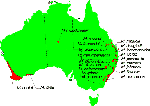
Distribution of Macrozamia (1).
Common Names
Taxonomic notes
Three described subspecies in NSW: the type, plurinervia, and flexuosa. A key is presented below.Allozyme studies have found low diversity in plants of this and closely related species, coupled with a high level of genetic differentiation between populations (2).
Description
"Stem mostly subterranean, 10-20 cm diam. Leaves 2-12 in the crown, 40-110 cm long; rachis strongly spirally twisted, often 3-5 times; pinnae 50-200, simple, entire or with 2 or 3 apical teeth, longest 10-30 cm long, 1-7 mm wide, sometimes a few of the basal ones reduced, with 1-7 veins prominent below; petiole 5-35 cm long. Male cones 8-25 cm long, 4-6 cm diam., spines to 0.7 cm long. Female cones 10-25 cm long, 7-8.5 cm diam., longest spines 1.5-4 cm long; seeds c. 3 cm long, orange to scarlet" (1).Key to subspecies in NSW:
"1. Petioles much flattened, 5-15 cm long, widest pinnae usually 2-4 mm wide, 3-5-veined and pale at base. In its typical form this subspecies is confined to S Qld, however some northern N.S.W. populations of subsp. plurinervia approach it. 10a subsp. pauli-guilielmi
1*. Petioles flattened to rounded, 5-35 cm long, if flattened and <15 cm long then the widest pinnae 4-7 mm wide and 6-10-veined and usually pinkish at base.
2. Petiole usually 5-20 cm long, 5-11 mm wide at the lowest pinnae; pinnae concave to convex, the widest 4-7 mm wide, 6-10-veined, often rather stiff and pinkish at base when living. Grows in dry sclerophyll forest or woodland on stony slopes of the tablelands and adjacent Slopes in the north and the Upper Hunter valley. NSW & Qld. 10b subsp. plurinervia L. Johnson
2*. Petiole 20-35 cm long, 4-8 mm wide at lowest pinnae; pinnae concave, the widest mostly 3-6 mm wide, usually 5- or 6-veined, lax and ± pink at base. Grows in sclerophyll forest on the coast and coastal ranges, chiefly in the southern part of the NC and the extreme north of the CC [NSW]. 10c subsp. flexuosa (C. Moore) L. Johnson" (1).
Range
Australia: NSW & Qld., chiefly in sclerophyll forest (1).Big Tree
Oldest
Ethnobotany
Observations
Remarks
Citations
(1) Jones 1993.(2). I.K. Sharma, D.L. Jones, P.I. Forster and A.G. Young. 1998. The extent and structure of genetic variation in the Macrozamia pauli-guilielmi complex (Zamiaceae). Biochemical Systematics and Ecology 26: 45-54. ABSTRACT: Allozyme variation in 12 enzyme systems coded by 17 loci was investigated in six populations of Macrozamia, including two populations of M. parcifolia, three populations of M. pauli-guilielmi and one population of M. crassifolia from Queensland (Australia) in order to measure the levels of genetic variation. This was required to establish whether the allozyme data supports recent taxonomic treatment. Seven loci were found to be monomorphic. All species were genetically depauperate, with low levels of genetic diversity (P = 17.6- 35.3%, A = 1.2-1.4, He = 0.02-0.11) compared with two (only) existing reports, and plants in general. Genetic differentiation among populations was high (GST = 0.47). UPGMA cluster analysis using Nei unbiased genetic distance showed M. parcifolia and M. pauli-guilielmi to be more similar genetically to each other than either is to M. crassifolia. This is concordant with groupings based on morphological characters, thus supporting the objectives of the investigation.
back | Macrozamia | Zamiaceae | home
This page is from the Gymnosperm Database
URL: http://www.geocities.com/~earlecj/za/ma/pauli_guilielmi.htm
Edited by Christopher J. Earle
E-mail:earlecj@earthlink.com
Last modified on 31-Oct-1999